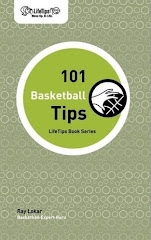It's good to have a organized Pressbreak that is consistent with how you attack after any made basket. This should be a set that flows directly from your transition game or early offense. There may be times when the opponent springs a press after a score, and you don't want to be disorganized or have to call a time-out to set up your pressbreak.
In this set after a made basket, 3 would inbound the ball quickly, preferably to 1 around the FT line. 2 would run the right lane for a possible over the top pass, 4 would run the left lane and 5 would sprint to the rim.
When a press is recognized the team enters the pressbreak seamlessly. 2 would come back to the ball and has the entire right lane to get open from the lane-line extended to the sidelines. 1 needs to get open in the box from that same lane-line to the opposite sideline and below the top of the key. 4 can begin cut to the top of the key and look for an open spot in the middle of the press. 5 continues to the rime to stretch the defense.
If the ball is entered to 1 or 2, the 4 man will diagonal cut toward half-court on the side the ball is entered - looking for a pass leading him to the sideline. This limits the chance for a defender to make the steal. If 4 does get a pass the opposite guard (1 or 2) can sprint the middle for a return pass and attack with numbers. After the ball is inbounded 3 needs to step in quickly and get out from under the basket in order to provide a safety return pass.
When one guard gets the inbound pass the opposite guard can drift up the floor a bit, but stay wide, in order to provide a diagonal pass. At all times in the pressbreak the player with the ball should have (in order of progression) a 1) straight ahead pass, 2) a diagonal pass, and 3) a safety pass. If the player is double teamed - and all of those are covered... then the 5 man stretching the defense deep must be open. If it everyone is matched-up man-to-man. The ballhandler should advance the ball via the controlled dribble until they feel pressure. If everyone stays spaced and it remains 1 on 1, this alone could break the press.
If the player feels pressure they should look at the progression 1) straight ahead 2) diagonal and 3) safety.
Now many coaches want someone "in the middle" of the press, as that is a great place to attack. I agree, however I think a bit differently. I think when you just place some one there, or alternate flashing a player, the defense can "get the rhythm" of your pressbreak. I like to CUT players through that middle and try to get them on the move so they can attack.
So if , for example, 2 reverses the ball to 3 they would immediately cut diagonally through the open space in the middle of the press. The inbounder, 3, would immediately look for the "give & go" if the defender happens to relax (that's why Give & Go's work). If it is not there immediately 3 should swing the ball to the opposite guard, who in turn should look at the diagonal cutter. 2 eventually becomes the straight ahead, 4 becomes the diagonal, and 1 should advance the ball up the floor until they feel pressure.
At that point, 3 is still a safety. 1 can reverse to 3, make a diagonal cut through the press, while 4 goes deep. When 1 vacates the lane, 2 can step up and fill that spot (I have never seen this player not open if we've been patient enough to get this far).If nothing has been open they've probably followed cutters and it should be a 1 on 1 situation.
At worse... the ball is now in the hands of what is normally one of your better players, who needs to make a play.
GET READY FOR GAME 7
-
The Indiana Pacers avoided an end to their season beating the New York
Knicks Friday night in Indy, 116-103. The series is tied 3-3. Game 7 is
Sunday, 3:30...
6 hours ago









